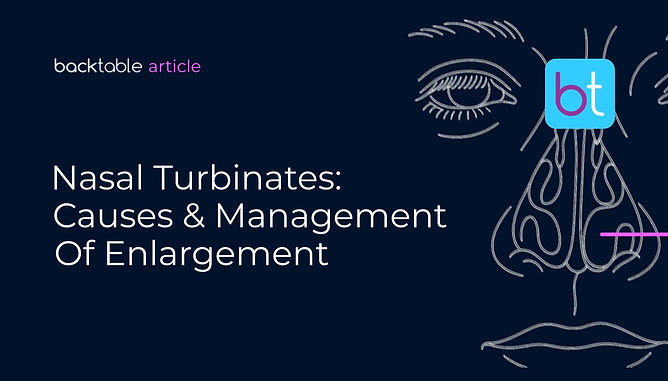BackTable / ENT / Article
Nasal Turbinates: Causes & Management of Enlargement
Bryant Schmitz • Updated Oct 2, 2025 • 38 hits
Nasal turbinates are key anatomical structures within the lateral nasal wall, essential for maintaining airway function, humidifying inspired air, and directing airflow. Their size and function directly influence nasal patency and airflow resistance. Hypertrophy or inflammation of these structures often presents as nasal obstruction and can significantly impact patient quality of life. Understanding the role of nasal turbinates, the consequences of their enlargement, and available treatment options allows for appropriate clinical management of nasal airway complaints. Turbinates become pathologic when hypertrophied due to chronic inflammation, allergy, or compensatory anatomical changes. Identifying the etiology and selecting effective treatment, whether medical or surgical, depends on thorough evaluation and anatomical understanding.

Table of Contents
(1) Anatomy & Function of Nasal Turbinates
(2) Etiology & Presentation of Enlarged Turbinates
(3) Diagnosis & Assessment
(4) Medical Management & Conservative Treatments
(5) Turbinate Reduction Procedures
(6) Post‑Procedure Care & Long‑Term Management
Anatomy & Function of Nasal Turbinates
Nasal turbinates, also called nasal conchae, are bony projections covered in vascularized mucosa along the lateral nasal wall. They are divided into three primary segments: inferior, middle, and superior turbinates. Occasionally, a fourth structure, the supreme turbinate, may be present. Of these, the inferior turbinate is the largest and most clinically significant in airway resistance.
These structures regulate nasal airflow and condition inspired air through humidification and filtration. The mucosa of the turbinates contains venous sinusoids capable of rapid engorgement or decongestion, dynamically adjusting airway caliber. This makes the turbinates both functional and reactive, particularly in conditions like allergic or vasomotor rhinitis. Normal nasal turbinates allow for unobstructed airflow while maintaining physiologic moisture and temperature.
Listen to the Full Podcast
Stay Up To Date
Follow:
Subscribe:
Sign Up:
Etiology & Presentation of Enlarged Turbinates
Enlarged turbinates are most commonly due to chronic inflammation, such as from allergic rhinitis or irritant exposure. Other causes include compensatory hypertrophy, especially in patients with septal deviation, where one turbinate enlarges to maintain airflow resistance balance.
Hypertrophy of nasal turbinates typically presents with bilateral or unilateral nasal congestion, mouth breathing, snoring, or reduced olfaction. In some cases, mucosal swelling may cause intermittent obstruction, especially when lying down. While many patients present with nonspecific nasal symptoms, examination often reveals visibly swollen turbinates, particularly the inferior ones.
Patients may ask, "what are turbinates?" when diagnosed, highlighting the importance of patient education around sinonasal anatomy and its impact on breathing.
Diagnosis & Assessment
Evaluating turbinate hypertrophy starts with a thorough history and physical exam. Nasal endoscopy remains the gold standard, allowing direct visualization of turbinate size, mucosal appearance, and dynamic changes in airflow obstruction.
Imaging, particularly CT scans of the sinuses, can be used in refractory cases or surgical planning. Assessing for normal nasal turbinates versus hypertrophic changes guides treatment planning. Important clinical considerations include distinguishing mucosal swelling from bony enlargement and evaluating associated pathology like septal deviation or polyps.
Medical Management & Conservative Treatments
Initial management of swollen turbinates typically involves addressing the underlying cause. For allergic or inflammatory etiologies, intranasal corticosteroids and oral antihistamines are first-line therapies. In cases of vasomotor rhinitis or nonspecific inflammation, saline irrigations and topical decongestants may offer temporary relief.
Medical management is effective for many patients but requires consistent use. Treatment response should be reassessed after 4–6 weeks. In cases where enlarged turbinates persist despite maximal medical therapy, procedural intervention may be considered.
Turbinate Reduction Procedures
Turbinate reduction is indicated for patients with persistent nasal obstruction due to turbinate hypertrophy unresponsive to conservative therapy. Techniques include submucosal resection, radiofrequency ablation, microdebrider-assisted turbinoplasty, and partial turbinectomy.
Submucosal approaches preserve mucosal integrity while reducing the bony core, minimizing complications like atrophic rhinitis. Enlarged inferior turbinate reduction is the most common target, as inferior turbinates contribute significantly to nasal resistance.
Procedure selection depends on symptom severity, turbinate anatomy, and surgeon experience. Office-based procedures offer reduced recovery time but may be limited in cases of significant bony hypertrophy.
Post‑Procedure Care & Long‑Term Management
Following turbinate reduction, postoperative care focuses on mucosal healing and preventing synechiae. Saline irrigations, intranasal steroids, and scheduled follow-ups support recovery. Crusting and mild discomfort are expected in the early healing phase.
Long-term management includes addressing underlying allergic or inflammatory drivers to prevent recurrent turbinate hypertrophy. Maintenance with nasal corticosteroids and allergen avoidance remains essential. Repeat procedures may be necessary in patients with refractory or recurrent symptoms.
Additional resources:
[1] Lam, D. J., James, K. T., & Weiss, R. L. (2003). Comparison of radiofrequency volumetric tissue reduction and submucosal resection for inferior turbinate hypertrophy. The Laryngoscope, 113(5), 882-886. https://doi.org/10.1097/00005537-200305000-00025
[2] Ciprandi, G., Cirillo, I., & Vizzaccaro, A. (2003). Nasal obstruction and inferior turbinate hypertrophy in allergic rhinitis: Effect of topical mometasone. Annals of Allergy, Asthma & Immunology, 90(3), 234–237. https://doi.org/10.1016/S1081-1206(10)62173-5
[3] Berger, G., & Ophir, D. (2000). The inferior turbinate: Histological and histochemical changes in response to submucosal electrocauterization. The Laryngoscope, 110(3 Pt 1), 414-421. https://doi.org/10.1097/00005537-200003000-00027
Podcast Contributors
Cite This Podcast
BackTable, LLC (Producer). (2022, September 27). Ep. 71 – Nasal vs. Mouth Breathing: Does it Matter? [Audio podcast]. Retrieved from https://www.backtable.com
Disclaimer: The Materials available on BackTable.com are for informational and educational purposes only and are not a substitute for the professional judgment of a healthcare professional in diagnosing and treating patients. The opinions expressed by participants of the BackTable Podcast belong solely to the participants, and do not necessarily reflect the views of BackTable.






